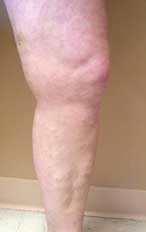Vein Treatment Clinic
Varicose veins and spider veins
More than 25 million Americans suffer from varicose veins and millions more are afraid to show their legs because of bulging or spider veins. This problem is more common in women but can also effect men. Causes vary, but pregnancy, genetic factors along with lifestyles or jobs that require standing for prolonged periods, put people at risk.
The disease is diagnosed and classified by physical examination and ultrasound imaging. Utilization of non-invasive duplex ultrasound technology allows vascular surgeons to identify the source of the varicose veins and develop a precise treatment plan.
Call the Virginia Mason Franciscan Health Vein Treatment Clinic today at 206-254-VEIN (8346) for more information or to schedule a consultation.
Treatment options
New catheter-based treatments are available which effectively seal the leaking valves and eliminate the varicose veins without the need for ligation and stripping. These catheters impart a heat injury to the vein wall that causes an inflammatory reaction and closure of the incompetent vein. Small, two-millimeter incisions are then used to remove the residual varicose veins.
The procedure, performed in an outpatient setting under either local or general anesthesia, usually takes one to two hours. Patients recover for approximately one hour and are discharged home. They are required to wear a compression dressing for two to three days. There is little or no postoperative pain, and patients are able and encouraged to walk immediately. Return to work and full activities are faster than with traditional ligation and stripping.

Pre-treatment

One week post-treatment
Before and after images courtesy of Michael Vasquez, MD
Our vein treatment specialists:
- Damon Pierce, MD
- Matthew E. Bennett, MD, RPVI
- Kerry E. Bowen, PA-C, MHS
- Carina Y. Walker, MCHS, PA-C
Call the Virginia Mason Franciscan Health Vein Treatment Clinic today at 206-254-VEIN (8346) for more information or to schedule a consultation.